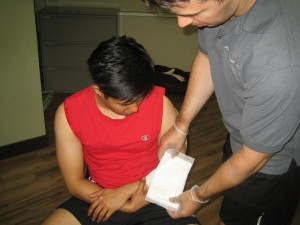When treating a draining wound, it is important to have an idea of what a normal drainage looks like. An open wound or a wound that is healing has different kinds of drainage. Drainage such as clear fluid, traces of blood and yellow discharge are common. This is due to the liquid and protein found between the muscles and tissues, and the color of the drainage depends on the severity and type of infection.
Normal wound drainage includes serous drainage which is clear, colorless drainage or a slightly yellowish and serosanguinous drainage which is a thin, watery discharge made of blood and serum. There is only a small amount of blood found in the discharge and the color is pinkish.
Abnormal drainage includes sanguinous drainage which has plenty of blood in it and colored bright red with purulent drainage or pus. The color of pus varies in color such as yellow, green, gray, white, brown or pink and with foul odor.

Treatment for a draining wound
- Wash hands properly before and after touching the wound of the person to minimize bacteria that enters the wound. Wet hands using warm or cold water and lather the hands using soap. Scrub the hands for at least 30 second to eliminate dirt and bacteria. Rinse the hand in running water and dry the hands using a clean towel.
- Wear disposable gloves as a barrier between bacteria and the wound.
- Place the wound under running water and clean using an antiseptic solution such as hydrogen peroxide or povidone iodine to remove dead skin cells and debris found in the wound. Soak a cotton ball or gauze in antiseptic solution and run it over the wound in a circular motion starting from the center of the wound until the edges of the wound. An antiseptic solution has germ killing properties for fast healing of the condition. Clean the wound at least once every day or when the bandage becomes wet or soiled.
- Apply the prescribed antibacterial ointment such as bacitracin at least 3 times every day.
- Cover the wound using guaze bandage to prevent the wound from getting infected. When the bandage is damp or soaked, change immediately to prevent the spread of bacteria in the area.
- If the bandages are soaked several times every day, it is a sign of abnormal wound drainage and necessitates immediate medical care. Severe wound bleeding or hemorrhage can be dangerous due to the loss of blood.
- Take the prescribed pain medications such as ibuprofen to lessen pain, fever and swelling.
